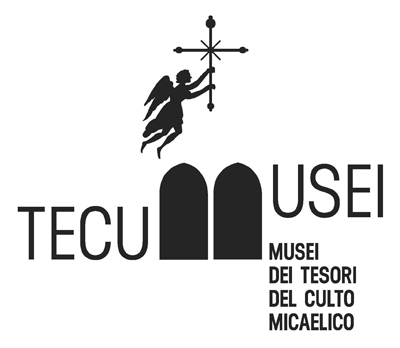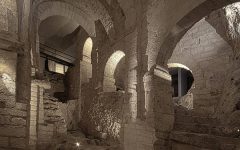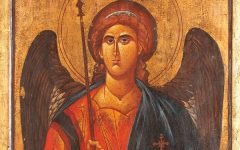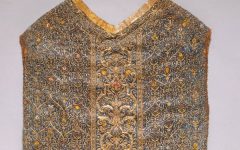
Crypts
THE LONGOBARS CRYPTS
They are the places of Byzantine and Longobard period, brought to light thanks to the excavations promoted by the Archdeacon of the Chapter, Nicola Quitadamo, in the years 1949-1960. They used to serve as the entrances to the grotto and were definitely abandoned in the 13th century, at the time of the Angevin constructions. Many inscriptions along the walls of the “crypts”, some of Runic characters, testify to the considerable influx of pilgrims since the Longobard epoch.
The “crypts” are composed of two rooms whose structures had to be made in two phases following immediately one after the other.
Some of the wall inscriptions, identified in 1974, have made it possible date the constructions from the end of the 7th to the beginning of the 8th century. The crypts, about 60mt. long, extend up to beneath the floor of the Basilica. The first room, about 45mt. long, comes up to the mighty supporting wall on which, in the upper part, the famous Bronze Doors rest. This first part seems like an arcade, made up of eight rectangular spans, communicating with each other through transversal arches, that detach from large pillars that jut out from the side walls. It is all covered with a barrel vault. Besides, during the work undertaken by the Benedictine Fathers in 1975, was discovered a mortuary cell with two sarcophaguses, one of them has not been opened; it has got a cover in mortar and a graffito cross dated 7th-8th century. In this suggestive room, various sculptures from the excavations of the shrine, from the ex-church of St. Peter and from the ruins of the Benedictine Abbey of St. Mary of Pulsano have been put on exhibition. All the finds exhibited here are dated from the 7th-8th century up to the 15th century.
Throughout the visit, pilgrims can admire a variety of finds that, once more, give witness to the glorious history of this place. Here are some of the most significant ones: the coat of arms of the City of Monte Sant’Angelo that dates back to 1401; different architectural elements (11th-12th century) such as fragments of columns, mullions in local stone, decorative elements; a Madonna and Child dated 15th century; a statue of St. Michael of the first half the 16th century; a statue of the Saviour dated 15th century; a font decorated with biblical scenes; various fragments of a pulpit, among which an eagle – dated 11th century – with lectern made in the atelier of local sculptor, Archdeacon Acceptus; fragments of pluteus (10th-11th century); a funeral cross (8th century); another sculpture representing St. Michael (14th century); an Angel with a standard (10th-11th century); a praying Christ (11th-12th century) and, of the same period, a headless Madonna. In one of the small rooms are housed some spiral columns with capitals dated 10th-11th century, a stiliforo lion of the same period, a paving-stone (8th-9th century); slabs of terra-cotta for tomb coverings, attributed by some to the 8th-9th century, by others to the Roman era; finally some fragments of paving-stone with graffiti that go back to the year 1066.
Passing through the opening excavated in the sustaining wall of the Bronze Doors, we find ourselves in the other room of the Longobard epoch, divided into two large naves, each one of them made up of a central flight of three round arches, and delimited at the north and south by other arches sustained by massive pillars. The roofing of this room was supposed to have been composed of a barrel vault sustained by transversal arches. The two naves were occupied by stairs: the one on the right has a curvilinear trend and is preserved integrally in its course; the one to the left had a rectilinear trend, but was completely destroyed during the work. The two stairs ended into a small floor, delimited to the east by an apse with an altar made up of squared blocks with traces of numerous inscriptions, to the north by some rooms whose entries were obstructed, and to the south by two entrances that gave onto the rocky slope opposite the grotto.
To the left of the altar a fresco called the “Custos Ecclesiae” has been discovered, protected by stone slabs that can be attributed to the 10th century. At present it is exhibited in the Conference Hall. From the remains of the frescoes and from the numerous inscriptions on the walls, we can understand the importance of the Shrine, especially for the Longobards.
These rooms were definitely separated from the Sacred Grotto towards the years 1270-1275, when the Angevins gave the current arrangement with the new constructions, sacrificing the preceding works built in honour of St. Michael Archangel.
Lapidarium Museum
LAPIDARIUM MUSEUM
Nella suggestiva galleria longobarda è ospitato il Museo Lapidario, patrimonio della Basilica, che raccoglie più di 200 manufatti scultorei di vario tipo provenienti dagli scavi del Santuario e da alcuni monumenti della città di Monte Sant’Angelo: l’ex chiesa di S. Pietro, il Battistero di San Giovanni in Tumba, l’abbazia di S. Maria di Pulsano e il complesso monastico dei Celestini.
Il nuovo assetto, realizzato nel 2015, si fonda sui più recenti criteri di museologia che permettono al materiale architettonico-decorativo, per quanto lontano dal proprio contesto di origine, di riacquistare un valore di insieme. L’allestimento è stato pensato per offrire al visitatore un numero cospicuo di reperti, evidenziando al tempo stesso quelli di maggiore rilevanza storica e peculiarità artistiche, in modo da predisporre ad una lettura attenta e coinvolgente.
L’intento è stato quello di mettere al centro del percorso il visitatore, permettendogli di rivivere la storia attraverso i luoghi, che pure non raggiunge fisicamente.
Il Museo Lapidario è un prezioso deposito aperto al pubblico. La dotazione è organizzata in scaffalature ed espositori e la semplicità organizzativa consente un’agevole lettura degli ambienti e dei reperti.
Fra i “pezzi” più significativi: lo stemma della Città di Monte Sant’Angelo dell’anno 1401; diversi elementi architettonici come frammenti di colonne, capitelli ed elementi decorativi a nastri intrecciati; una figura orante del secolo XII e, dello stesso periodo, una Madonna acefala appartenuti alla demolita chiesa di S. Pietro. Dell’abbazia di S. Maria di Pulsano si possono ammirare una base di cero pasquale o di acquasantiera finemente scolpita del XII secolo e una maestosa “fontana lustrale” decorata con scene bibliche. Dal Santuario provengono in particolare una statua di S. Michele del secolo XIV-XV, una Madonna con Bambino del secolo XV, una statua del Redentore variamente datata tra XIV e XV secolo, un architrave con angelo e decorazioni a girali della metà del secolo XI e frammenti di lastra con graffiti dello stesso periodo. Di notevole pregio sono i vari frammenti di un ambone, realizzato dallo scultore locale Acceptus e datato al 1041, fra i quali un’aquila con leggio, dei capitelli e delle travi scolpite.
Passando attraverso una stretta apertura, si accede ad un altro ambiente di epoca longobarda, diviso centralmente in due parti da tre arcate a tutto sesto. A sinistra si trova l’antico ingresso di epoca pre longobarda chiamato “porta di Pietro e Paolo”, come riportato dall’iscrizione sul piedritto che ricorda i due Santi. Sono ben visibili due scalinate: quella di destra, detta “tortuosa”, ad andamento curvilineo e quella di sinistra ad andamento rettilineo, le quali permettevano l’accesso alla Grotta e il deflusso dei pellegrini. In alto, su una piccola platea, è visibile un altare a blocco, detto “delle impronte”, sul quale l’Arcangelo avrebbe lasciato le sue orme. Alla sinistra dell’altare, è stato ritrovato, protetto dalle lastre di pietra, un affresco chiamato il Custos Ecclesiae attribuibile al secolo XI, oggi esposto nel Museo Devozionale.
Devotional Museum
THE DEVOTIONAL MUSEUM
It was born in 1989 with the aim of gathering, cataloguing and displaying the different objects that witness the fervent devotion of many generations to St. Michael.
A large part of it is made up of gifts offered to the Sanctuary by both famous and unknown pilgrims, most of them were given as a sign of recognition for graces received throughout the multi-century history of this shrine.
These feelings are particularly expressed through the “ex-voto” in the form of paintings that “visually” tell about the graces and miracles obtained through the intercession of the Archangel.
The treasured objects are many and varied.
The most precious ones are the liturgical vestments, chalices, crosses, silver lamps, censers, little boats, candelabra, reliquaries: objects accumulated for the most part during the last two centuries.
Also very interesting are:
- a series of archaeological exhibits, donated by dr. Philip Prencipe;
- the collection of coins and medals, among them there are some Greek coins which date back to the 6th-3rd centuries BC;
- copies of some panels of the Bronze Doors of the Sanctuary, reproduced on slabs of stone (18th-19th century).
Another important section of the Museum houses objects and testimonies of the popular religiosity of the dwellers of the Archangel Town and of all Gargano area. Deserving to be admired are the so-called “Glass Bells” which enclose statues of saints that in ancient times used to occupy a place of great respect in every homes; then, there is an interesting collection of statues depicting St. Michael made by statue sculptors who used local stone or alabaster and, through family tradition, they passed on from generation to generation this exclusive privilege conceded by king Ferdinand of Aragon to the artists of Monte Sant’Angelo in 1475.
Furthermore there are some objects obtained more recently:
- various vases and ceramics painted by the Abruzzese school;
- a Nativity sculpted by the artists of Ortisei (Bz);
- a collection of statuettes made of leather and reproducing scenes of family life and a pilgrimage to the Gargano;
- a votive habit of St. Michael;
- a collection of plates and cups representing St. Michael;
- an evocative collection of decorated votive candles is also very precious.
A remarkable and interesting part of the devotional Museum is comprised of a collection icons of the Blessed Virgin and of Saints, very fine examples of the Russian-Slavic School, and copies of icons kept in Greece, inspired by the figure of the Archangel.
However, in this Museum the central place belongs to the most ancient icon of St. Michael venerated in the Sanctuary. Originally, up until 1891 it was kept in the so-called Cave of the Stones, then, it was kept in the Chapel of the Relics for some time. This work of great value is realized in gilded copper and is known as Byzantine Icon and dated 6th-7th century but, according to some recent studies its origin is attributed to the Longobard period (8th-9th century). All these gifts offered to the Sanctuary of Monte Sant’Angelo are a witness to the love, devotion and cult of St. Michael through the centuries. They attest to the vitality and importance of this sacred place for pilgrims and visitors who arrived at the shrine from all over the world.















